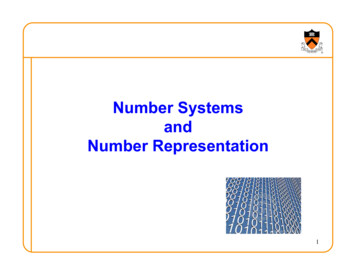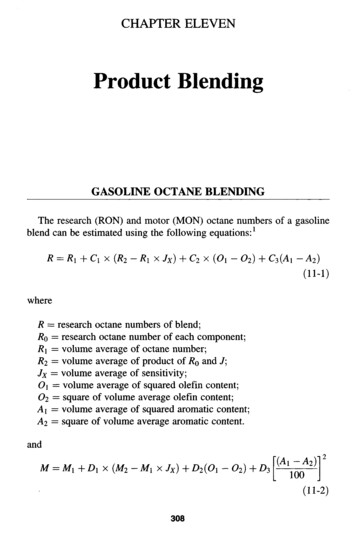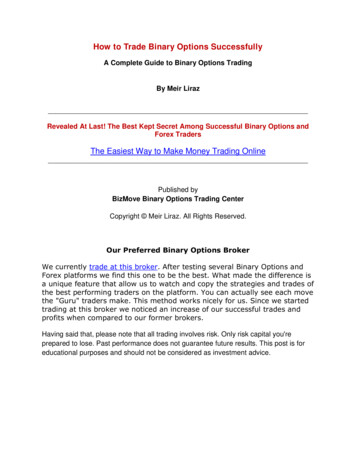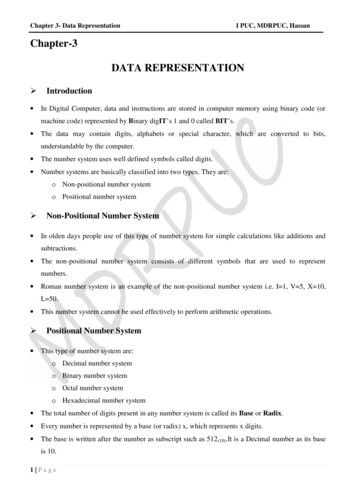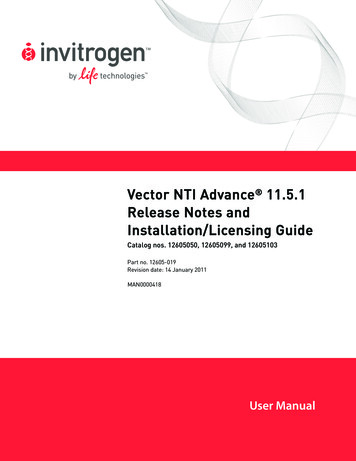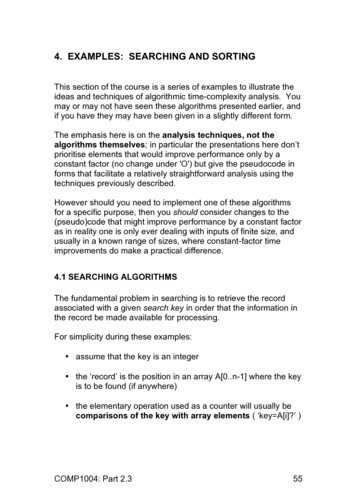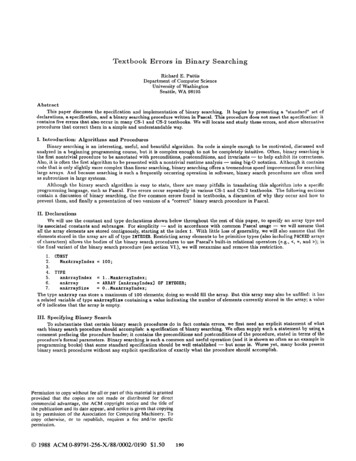
Transcription
TextbookErrorsin BinarySearchingRichard E. PattisDepartmentof Computer ScienceUniversityof WashingtonSeattle, WA 98195AbstractThis paper discusses the specificationand implementationof binary searching.It begins by presenting a “staudard”set ofdeclarations,a specification,and a binary searching procedure written in Pascal. This procedure does not meet the specification:itcontains five errors that also occur in many CS-1 and CS-2 textbooks.We will locate and study these errors, and show alternativeprocedures that correct them in a simple and understandableway.I. Introduction:AlgorithmsandProceduresBinary searching is an interesting,useful, and beautiful algorithm.Its code is simple enough to be motivated,discussed andanalyzed in a beginning programmingcourse, but it is complex enough to not be completelyintuitive.Often, binary searching isthe first nontrivialprocedure to be annotated with preconditions,postconditions,and invariants - to help exhibit its correctness.Also, it is often the first algorithm to be presented with a nontrivialruntime analysis - using big-0 notation.Although it containscode that is only slightly more complex than linear searching, binary searching offers a tremendous speed improvementfor searchinglarge arrays. And because searching is such a frequently occurring operation in software, binary search procedures are often usedas subroutinesin large systems.Althoughthe binary search algorithmis easy to state, there are many pitfalls in translatingthis algorithminto a specificprogramminglanguage, such as Pascal. Five errors occur repeatedly in various (X-1 and CS-2 textbooks.The following sectionscontain a discussion of binary searching, the five common errors found in textbooks,a discussion of why they occur and how toprevent them, and finally a presentationof two versions of a “correct”binary search procedure in Pascal.II. Declarations’We will use the constant and type declarationsshown below throughoutthe rest of this paper, to specify an array type andits associated constants and subranges.For simplicity- and in accordance with common Pascal usage - we will assume thatall the array elements are stored contiguously,starting at the index 1. With little loss of generality,we will also assume that theelements stored in the array are all of type INTEGER. Restrictingarray elements to be primitivetypes (also including PACKED arraysof characters)allows the bodies of the binary search procedures to use Pascal’s built-in relationaloperators (e.g., , , and ); inthe final variant of the binary search procedure (see section VI.), we will reexamine and remove this restriction.1. CDNST2.MaxArrayIndex 100;3.4. TYPE5.anArrayIndex l.MaxArrayIndex;6.anArray ARRAY CanArrayIndex]OF INTEGER;7.anArraySize O.UaxArrayIndex;The type anArray can store a maximum of 100 elements; doing so would fill the array. But this arraya related variable of type anArraySizecontaining a value indicatingthe number of elements currentlyof 0 indicates that the array is empty.III.may also be unfilled: it hasstored in the array; a valueSpecifyiugBinarySearchTo substantiatethat certain binary search procedures do in fact contain errors, we first need an explicit statement of whateach binary search procedure should accomplish:a specificationof binary searching. We often supply such a statement by using acomment prefacing the procedure header; it contains the preconditionsand postconditionsof the procedure, stated in terms of theprocedure’s formal parameters.Binary searching is such a common and useful operation (and it is shown so often as an example inprogrammingbooks) that some standard specificationshould be well established - but none is. Worse yet, many books presentbinary search procedures without any explicit specificationof exactly what the procedure should accomplish.Permission to copy without fee all or pact of this material is grantedprovided that the copies ace not made or distributedfor directcommercial advantage, the ACM copyright notice and the title ofthe publication and its date appear, and notice is given that copyingis by permission of the Association for Computing Machinery. Tocopy otherwise, or to republish, requires a fee and/or 90 1.50190
Listed below is a specificationfor binary searching, consisting of a comment and its associated procedure header. I do not assertthat this is the one true specification,but it seems to have a certain commonalitywith all the specificationsthat books present- or in the absence of such a specification,what the code they present tries to accomplish.One common variant specifies binarysearching as a function that returns the index of the position of the element that is being searched for - and returns a specialdefault value (often 0) when that, element is not present in the array. Another variant returns informationpartiallythrough a VARparameter and partiallythrough the value returned by a function. These differences are irrelevantto the content of this paper.The comment below dilferentiatesbetween two forms of preconditions:PreC and PraU. The PreC preconditionsare ensuredvalid by the compiler or runtime system, or are checked by the procedure itself; the PreU preconditionsare not checked explicitly(but must still be true for each set of actual parameters, to ensure that each procedure call operates correctly).For example, thePreC precondition0 Size MaxArrayIndexis ensured by runtime subrange checking: because the formal parameter Size isa subrange type, anArraySize.Pascal detects a runtime error if the actual parameter is outside of the range 0. .MaxArrayIndex.Alternativeiy,if the less-restrictivetype INTEGER were used for the Size parameter, it would be inexpensive to perform an explicitcheck on the vaIue of Size with an IF statement at the beginning of the procedure’s body.The PreU preconditionthat array A is sorted is not explicitlychecked: to do so would require examining each element inthe array, which would require O(Size)time and nullify the speed advantage of binary searching over linear searching.Somespecificationsfor binary searching strengthen this preconditionto state that the array is in strictly ascending order, excluding thepossibilityof duplicate values and ensuring that at most one element in the array can be equal to Key. We omit this restriction;without it, for instance, binary searching cannot be guaranteed to return the exact same answer as linear searching.1. (*****BinarySearch2.PreC: 0 Size MaxArrayIndex.3.PreU: A is sortedin nondescendingorder(I I J Size : AC11 ACJ3).4.Post:If thereexistsan I such that(1 I Size)and AC11 Key thenFound FALSE and5.Found TRUE and Index q I. If no such I exists,the value of Index is undefined.6.7.Note: If Key appearsin arrayA multipletimes,then Found TRUE and8.Index willbe set to some arbitraryI. such that AC11 Key.9.Time: O(Log Size)10. *****)11.(* EFFICIENCY *)12. PROCEDURE BinarySearch(VAR A: anArray;13.Size: anArraySize;14.: INTEGER;Key15.VAR Found : BOOLEAN;1G.VAR Index : anArrayIndex);If any checked preconditionfails, the result should be an execution error, or printing some explicit error message, or settingsome error indicator.There are different opinions as to whether (and how) such failures should be reported back to the call sitein a graceful manner, where further corrective action might be taken, or whether an execution error should result - terminatingall the code. This interesting topic is beyond the scope of this paper. Here, we will not be concerned with the actual method ofreporting the discovery of a failed precondition.But if any preconditionfails to hold, BinarySearchis not required to meet itspostconditions(i.e., it is not guaranteed to return a eThe following Pascal procedure is a contrived combinationof all the worst features of the code appearing in introductoryprogramming texts (ACM’s CS-1 curriculum1 and beninninn algorithm and data structures texts (ACM’s CS-2 curriculum).Althounh&is prociduremay look effective at first glance, it-contayns ive errors that we will examine in hetail. These errors are logical: thiyare not reIated to machine-specificproblems such as arithmeticrounding or .18.19.PROCEDURE BinarySearchVAR Low, HighBEGINLow : 1’High: Size;(ASizeKeyVAR FoundVAR Index: anArrayIndex;:::::anArray;anArrayS ize ;INTEGER;BOOLEAN;anArrayIndex);REPEATIndex: (Low High) DIV 2;IF Key A[Index]THEN High: Index-lELSE Low : Index 1UNTIL (Low High) OR (Key ACIndexl);Found: END;(Low High)191
V. TheErrorsThe errors discussed in this section allow Binary&arch,Time specification(Error 1); (b) produce spurious executioneven when all its preconditionsare satisfied, to (a) fail to satisfy itserrors (Errors 2,4,5); or (c) produce an incorrect answer (Error 3).Error1: This proceduredoes not run in thne O(logSize).The raison d’etre for studying and using binary searching isits speed advantage (operatingon large arrays) over the simpler method of linear searching. Binary searching should run iu timeO(logSize):if the input size is doubled, the worst-case number of operations(comparisons,arithmeticoperators,array access,etc.) rises by just a constant. Yet in this BinarySearchprocedure, the array A is passed a.s a value (not VAR) parameter.Virtuallya11 Pascal compilers will transmit this parameter by first copying every element from the actual array parameter into the formalarray parameter; only then will the binary searching code execute, In such a scenario, the running time is more accurately statedas O(Size) f 0( log Size) O(S&).In an even worse scenario, some textbooks present a recursive version of BinarySearch,which repeatedly passes the array tobe searched as a non-VAR formal parameter to each recursive invocationof this procedure.In this case, the entire array is copiednot just once, but once for each recursive call. The running time of such code rises to O(Sire logsite).Finally, with a non-VAR formal parameter,the amount of extra space needed by this Binary&archprocedure increases fromO(1) to O(Size);in the case of a recursive procedure,the amount of extra space may increase to O(SizelogSi.ze).On smallmachines - or compilers using the small machine model for code generation - passing large arrays in such a manner may causean unexpected execution error, because of lack of available stack space.The array A should be passed as a VAR parameter, with a special side-bar comment indicatingthat the reason is based purelyon efficiency, not because the actual parameter is being modified. In this case, the two parameter modes available in Pascal do notallow us to specify our intent perspicuously;the semantics of the Ada IN mode more closely reflects our requirements.Error 2: Tliis procedurecauses an executionerror wheneverSize 0. In the procedure above, with Size 0, the firstevaluation of the expression (Low High) DIV 2 will result in the value 0, which causes a subrange-out-of-boundsexecution error,when it is assigned to the variable IndexEven if the type of Index were expanded to INTEGER - avoiding this particular error the subsequent array access that uses Index (in the IF statement in line 13) would cause an array-out-of-boundsexecution error.For this error there are two problems to address: First, is the preconditionthat Size r 0 appropriate(instead of the morerestrictive Size O)? Second, what is the underlyingcause of this error and how can it be fixed?An easy way to dismiss this error is to change the specificationof BinarySearchto require that PreC: Size 0, mandatingthat the array be nonempty.This new preconditioncan be easily implementedby changing the type of Size from anArraySize(which includes the value 0) to anArrayIndex(whose lowest value is 1). Or, we could change the definitionof anArraySizeto omitthe possibilityof an empty array. But a common use of binary searching is to continuallybuild, query, and remove informationfrom a table; such tables start empty and may become empty at various times during program execution.We shall see below,allowing for Size 0 does not decrease the understandabilityof the code; in fact, we will study a procedure that allows this weakerpreconditionand is also more understandablethan the BinarySearchprocedure shown above.The underlyingcause of this error is the use of the REPEAT/UNTIL control structure,which is inappropriateand confusing.Fundamentally,this control structure must execute its body at least once; but with an empty array, the body should be executedzero times. We could include a special IF test to avoid causing an error in this special case, but such extra code would only obfuscateour procedure even more, and take us further from our goal of writing an easy to understand and correct binary search procedure:these two goals are strongly linked.This simple argument alone advocates for the use of a WHILE control structure,which cansucciuctly and correctly implement binary searching. But there is even a more compelling reason underlyingthe inappropriatenessof the REPEAT/UNTIL loop containing an IF statement.Iu its simpIest form, the binary search algorithm (as opposed to Pascal code) performs a trichotomouscomparison betweenKey aud ACIndexl.If the two are equal, the answer is known; if they are not equal, either Low is increased or High is decreased.One reason that the BinarySearchprocedure shown above is so difficult to understand and prove correct is that this trichotomouscomparison is lexically split: the and ? tests are performed by the IF statement itself, but the test is performed in the UNTILclause. Thus, this single algorithmicconcept is distributedinto two control structures in the code, resulting in a lack of cohesiveness.Also, notice that because the and test are combined in the ELSE clause, either Low or Eigh is always changed at the end of everyiteration - even if Key has been found at the Index position; this nonintuitiveoperation contributesto Errors 3 and 5, which westudy below.Error 3: This procedurereturnsa wrong answer because it sets Found to FALSE, wheneverthe beginningof the finaliterationof the REPEAT/UNTIL loop has Low High - regardlessof whetherKey is storedin the array.Such a case,for instance, occurs whenever Size 1. Because repeatedly executing the loop on larger arrays reduces the distance between Lowand High, in many cases this distance eventuallybecomes zero, meaning Lou High; in all these cases BinarySearchmay alsoproduce au incorrect answer.our analysis from Error 2, based ou theThe problem is in the post-loop aasigument to the parameter Found. Continuinginadequacy of the RBPEAT/UNTIL loop, we see that the value of the parameter Index is directly related to the local variables LOWand High: whenever Index is used, it should always specify the midpoint between the current values of Low and High. But in t1iisprocedure, the UNTIL clause combines testing the new values of Lou and High (one has just changed) with the value of AfIndsxl,where Index is computed as the midpoint of the old values of Low and High. So, these three variables are not correctly synchromzed.thus, it is possible to terminate a loop with both A[Index] Key and Low High. Look at a procedure call with Size Key C AC11 was1 and Key ACl]. At the end of the first iterationwe have Index 1, and LOU 2 because the comparisonfalse, and High 1. Thus, the 100 exits because both Key AfIndexland Low High. In this case the assignment statementincorrectlysets Found to FALSE.192
We can fix this problem by replacing the post-loop assignment statement by Found: (Key ACIndexl 1. Although it is subtleto analyze, for the reasons explained above, such a procedure will always produce the correct answer. In the next section we willstudy binary searching procedure that uses a WHILE loop, which alleviates all these problems while simplifyingthe code too.Error 4: This procedurecauses an executionerror wheneverSize 0 and the value of Key is strictlyless than theelerncntstoredin ACll.Notice that in this case, eventually LOW will contain the value 1 and High will contain the value I or2. This state will occur because the IF test will continuallybe true (because Key is strictly less than every element in the array),so Low will remain unchanged while High will continuallybe decreased until it is equal to I or 2. During the next iteration of theREPEAT loop, Index will receive the value 1, and once again the IF test in line 13 will be true. But the next assignment statementsets High to be 0 (which is the value of Index-l),and that will cause a subrange-out-of-boundsexecution error, because the typeof High is the subrange type anArrayIndex.An easy way to fix this error is to expand the subrange of High so that it also includesthe value 0. See the discussion of the next error for a continued analysis in this line of reasoning.Error 5: This procedurecauses an executionerror wheneverSize NaxArrayIndexand the value of Key is greaterthan or equal to tire elementstore in A [MaxArrayIndexl.For reasons analogous to those in Error 4, eventually both Low andHigh will contain the value of MaxArrayIndex.During the next iteration of the REPEAT/UNTIL loop Index will receive the valueMaxArrayIndextoo, and once again the IF test will be false; remember that we saw at the end of the discussion of Error 2, evenwhen Key ALIndexthe ELSE clause will be executed, changing the value of Low. But the next assignment statement sets Low tobe MaxArrayIndex l(which is the value of Index l),and that will also cause a subrange-out-of-boundsexecution error, becausethe type of Low is also the subrange type anArrayIndsx.This error is of a similar nature to Error 4, but it a bit more subtle and much more likely to by bypassed during testing: theconditions under which it occurs are quite restrictive.But it is not unfeasible to think of a program that must read, store in anordered array, and continue processing exactly MaxArrayIndexelements; so searching a filled array for its largest element, or anelement that is larger, could occur in actual programs.I would be less apt to criticize such an error if it were present in someobscure and little studied procedure; but I feel that I can legitimatelyhold up binary search procedures to this level of scrutiny.In their rush to use the strictest possible subranges, some authors have forgotten that it is possible for Low or High to exceedthe bounds of their “obvious”subranges. Again, an easy way to fix this error is to expand the subrange of Low so that it includesthe value MaxArrayIndex l.This type would be clumsy to specify in Pascal, because Pascal disallows constants computed fromother constants; but such constants are easy to specify in Modula-2 or Ada. Unfortunately,such an approach would create anasymmetry between the Low and High variables: they would be of different types. Rather than decreasing the understandabilityofsuch code by creating new subrange types (which admittedlyincreases its precision), the types of both these variables should bechanged to INTEGER; some authors define and use the subrange 0. . MaxArrayIndex lfor both.An incorrect attempt to fix both Error 3 and Error 4 is to change the disjunction(Low High) OR (Key ACIndexl)into(Low 1 High) OR (K ey ACIndex]).Although this restrictionappears to fix the problem, disallowingLow and High fromwandering outside of the anArrayIndexsubrange, such code produces incorrect answers because the value of Index used in thepost-loop assignment statement remains unsynchronizedwith the current values of boa and High - one of which just changedwithout the necessary recomputationof Index. This problem was discussed at the end of the sections explainingErrors 2, 3, and5. Actually, it too can be overcome, but at the cost of tremendouslycomplicatingthe post-loop testing code.Finally, all the fixes described for errors 4 and 5 would be very difficult to justify and implement if the subrange type used todeclare anArray were an enumerated type, with absolute first and last elements. In such a case, gracefully extending the subrangewould be very dificult.VI.AlternativeBinarySearch ProceduresIn this section we examine two Pascal procedures for binary searching that do not exhibit any of the five errors discussed above.I have tried to write this code as cleanly as possible, displaying it in a style that promotes understandability.In these procedures,the number of non-blank lines of code is smaller than in any corrected version of the previously discussed binary search procedure.And, I assert that these procedures are easier to understand than the previous one; therefore it is easier to convince ourselves thatthis code is correct. Smaller isn’t necessarily better (sometimes too much “redundant”informationis removed), but it is often thecase that smaller procedures are easier to 17.18.PROCEDURE BinarySearch(VARASizeKeyVAR FoundVAR rayIndex);(*EFFICIENCY* VAR Low, High : INTEGER;BEGINLow : 1;High : Size;Found: FALSE;WHILE (NOT Found) AND (Low High)Index: (Low High) DIV 2;THENKey ACIndex]IFTHENELSE IF Key ACIndexl(* IF Key A[Index]*)ELSEENDEND;DO BEGINFound: TRUEEigh : Index-lLow : Index 1193(*(*(*(*(*searching?stillcompute midpointtrichotomp .C, found or alterLow/Highbound* *)*)*)*
Note that the formal parameter A is declared to be a VAR parameter, with an appropriateside-bar comment stating why. If Size 0, the body of the loop will not be executed, and the procedure will immediatelyreturn with Found set to FALSE. The parameterFound is explicitlyset to TRUE exactly when a comparison showed Key to be located at ALIndex];in such a case, neither Lou ncrHigh change. The local variables Lou and High are of type INTEGER, so there is no possibilityof a subrange-out-of-boundsexecutionerror (again assuming that KaxArrayIndexis not close to the maximum INTEGER value storable on a machine).A further generalizationand simplificationof BinarySearchallows for passing an explicit trichotomyfunction as a parameterto this procedure.There are two advantages to this style of coding: First, in this new version of BinarySearchthere is nodependence on using Pascal’s built-in relationaloperators;thus, this procedure can be used to search arrays of records - theTrichotomyfunction determines how the array of records was sorted (e.g., which field or combinationof fields to compare). Usingthis technique, BinarySearchcan be adapted to new array types more easily - the only remaining generalizationwould be tochange the array type, the Key formal parameter, and the A. B formal parameters of Trichotomyto be the same named type, such asanElementType.Second, this code is cleaner (it more closely resembles the algorithm):the “trichotomous”nature of this problemis now explicit in the TrichotomyValuetype, Trichotomyformal parameter, and CASE statement.A complete version of this procedure is shown below, including the declarationof the new enumerated type TrichotomyValue.Procedures as parameters are available is many Pascal implementationsand all Modula-2 implementations(although in a slightlydirerent syntactic form from the one shown s.19.20.21.22.23.24.TYPE TrichotomyValue (FirstLess.PROCEDURE BinarySearch(VAR ASizeKeyVAR FoundVAR ON (A,B(*: INTEGER)EFFICIENCY*): TrichotomyValue);VAR Lou, High : INTEGER;BEGINLOW : 1;High : Size;Found: FALSE;WHILE (NOT Found)Index: (Low CASE AND (LOU Bigh) DO BEGINHigh) DIV 2;(Key, AfIndex])OF: Found: TRUE: High : Index-l: Low : Index 1(* stillsearching?(* compute midpoint* * (* lower(* raise* * HighLowpointpointFinally, I do not assert that these procedures are correct; only that I am unable at present to find any errors in them. In apaper such as this one, which takes pot-shots at other persons code, I will gladly receive (and likewise publish) criticism that heIpsme better understand binary searching and its implementations.VIII.Summaryand ConclusionAlthough binary searching is an easy to understand and much studied algorithm,many expositions of binary search subroutinescontain errors. In thie paper we have examined the specificationof binary searching, catalogued and discussed five common errors,and proposed two alternativeprocedures that met this specificationand avoided the common errors.IX.PostscriptWhile writingthis paper, I conducted an informal survey of twenty well known CS-1 and CS-2 textbooks(all containingbinary search subroutineswritten in Pascal). Because of space restrictions,I was unable to include this survey in the conferenceproceedings; but I will hand out a copy of this survey at my talk, and I wili be glad to send a copy to anyone who writes me. Insummary, of these twenty books, only five had “correct” subroutines.Of the remaining sixteen, there were eleven instances of Error1, six of Error 2, two each of Error 3 and Error 4, and one of Error 5; note that some subroutines contained multiple errors. I hopeto expand the number of books surveyed by the time of the SIGCSE conference.Finally, I hope to publish a companion paper in the near future that continues to discuss binary searching from a perspectiveof software engineering.This paper will include a discussion of how to avoid all execution errors in binary searching - regardless ofmachine arithmeticmodels, array subranges, and array sizes - and how to frequently detect violationsof the PreU: preconditionthat tire array is sorted - but not increase the procedure’s complexityclass.194
Binary searching is an interesting, useful, and beautiful algorithm. Its code is simple enough to be motivated, discussed and analyzed in a beginning programming course, but it is complex enough to not be complete
